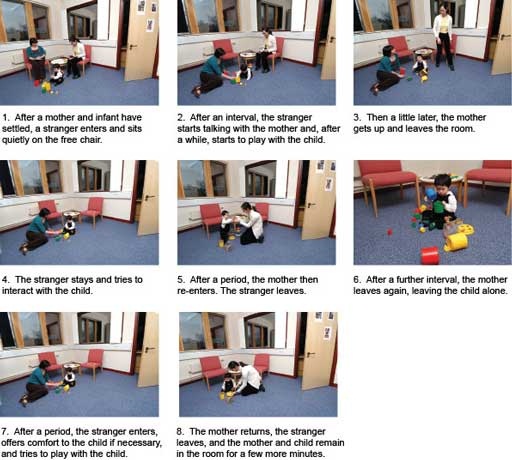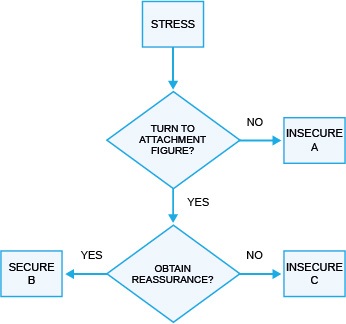3 Attachment classification
Ainsworth, who spent some years in the early 1950s working with Bowlby, initially examined the effects of ‘maternal deprivation’ (the lack of an adequate mother experience in infancy) on children’s development (Ainsworth, 1962).
In 1954, she left for Africa, and moved attachment theory forward through her observations of 28 mothers and their children in Uganda. She noted that, although there were some important differences between children in how they behaved when they were separated from their mothers, it was actually during reunions after separations that differences between children’s behaviours were most evident. She identified three different types of attachment: secure, insecure and absent. She later spent a long period in Baltimore, USA, closely observing and recording the behaviour of two further samples of infants and their mothers. It was during this time that she clarified her attachment categories by subdividing the insecure classification into two. She also developed a standard method for assessing attachment in infants aged around 1 year, the ‘Strange Situation Test’ (SST), which has become a ‘gold standard’ laboratory technique for attachment researchers (Ainsworth et al., 1978).
The procedure has eight episodes, designed to expose infants to increasing amounts of stress in order to observe how they organise their attachment behaviours with their parents when distressed by: being in an unfamiliar environment, the entrance of an unfamiliar adult, and brief separations from the parent.
Box 1: The Strange Situation Test
This assessment is carried out in an observation laboratory, with video cameras to record the behaviour of mothers and their infants. The room contains two easy chairs, a play area, perhaps defined by a rug, and a set of toys.
After a mother and infant have settled, a series of eight episodes follows. The video recording of the whole session is then coded by trained observers. (This method of assessing and classifying attachment is discussed further in Section 6.)
According to attachment theory, infants who have formed a good attachment to one or both parents should be able to use these figures as secure bases from which to explore the novel environment, because their IWMs contain representations of available parent figures. The stranger’s entrance should lead infants to inhibit exploration and draw a little closer to their parents, at least temporarily. The parent’s departure should lead infants to attempt to bring them back by crying or searching, and to less exploration of the room and toys. Following the parent’s return, infants should seek to re-engage in interaction and, if distressed, perhaps ask to be cuddled and comforted. The same responses should occur, with somewhat greater intensity, following the second separation and reunion. In fact, this is how about 65 per cent of infants, studied in a number of different countries, behave in the Strange Situation (van IJzendoorn and Kroonenberg, 1988), although there is substantial variation in this figure both within and between countries. Following the definitions developed by Ainsworth and her colleagues, these infants’ relationships are classified as securely attached (Type B) because their behaviour conforms to theoretical predictions about how babies should behave in relation to their primary caregiver if they have established a good attachment.
By contrast, some infants seem unable or unwilling to use their parents as secure bases from which to explore, and they are called insecure. Some insecure infants are distressed by their parents’ absence, and behave ambivalently on reunion, seeking contact and interaction but angrily rejecting it when it is offered. These infants are conventionally labelled insecure-resistant or ambivalent (Type C). They typically account for approximately 15 per cent of infants (van IJzendoorn and Kroonenberg, 1988). Other insecure infants seem little concerned by their parents’ absence. Instead of greeting their parents on reunion, they actively avoid interaction and ignore their parents’ bids. These infants are said to show insecure-avoidant attachments (Type A) and they typically constitute about 20 per cent of infants (van IJzendoorn and Kroonenberg, 1988). Further research has also described a fourth group of infants (Type D), whose behaviour is ‘disoriented’ and/or ‘disorganised’ (Main and Solomon, 1990). These infants simultaneously show contradictory behaviour patterns, and incomplete or undirected movements, and they seem to be confused or apprehensive about approaching their parents. Many of these infants appear to have been maltreated by their parents.
These varied reactions (for the three main categories) can be summarised in a simple flow chart:
The generally accepted coding system for the SST further classifies a child’s attachment into a sub-category of the three main categories (A1, A2, B1, B2, B3, B4, C1 and C2).
Research summary 1: How good is the SST as a measure of attachment?
One measure of the value of the SST is that it has been used in a large number of studies that have identified associations between SST attachment classifications and preceding, contemporaneous, and subsequent developmental measures. It is limited, however, in that it can only be used with children aged between about 9 and 18 months. A standard way of assessing the reliability of a measure is to repeat it within a short time period. Unfortunately, this is not possible with the SST as the assessment sensitises children and they react differently if the procedure is repeated. There have been criticisms of the categorical nature of the coding, and attempts have been made to instead use a series of rating scales, but these have not been very successful and are not commonly used. Observations of children in the home situation, and parental report using structured methods, have also been used and these have, in the main, been found to correlate with SST classifications. However, the crucial feature of the SST is that it ‘activates the attachment system’, which is not the case for children in their home environment, where they are likely to feel more secure.


